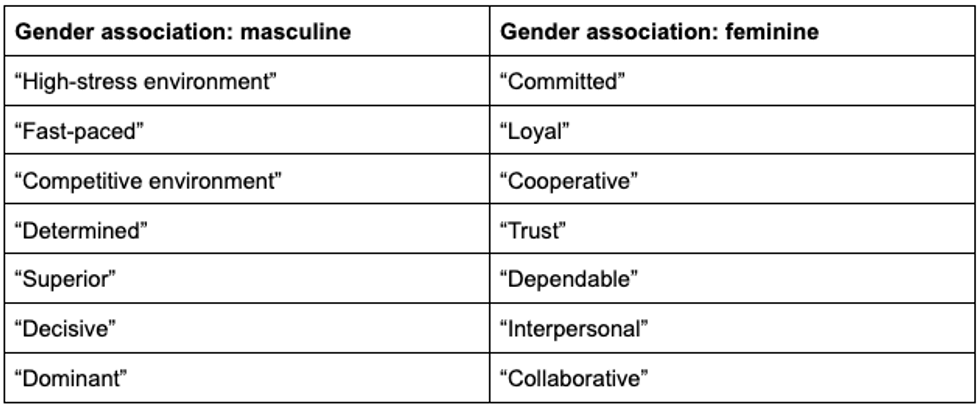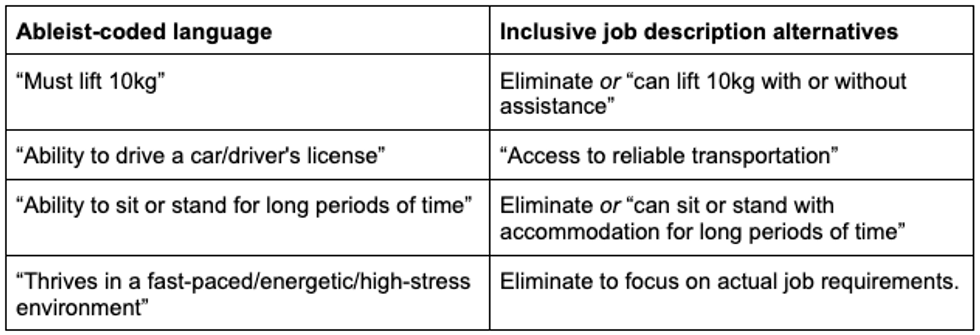Inclusive job descriptions make a strong impact on the talent you attract. Case in point? Social media management firm Buffer increased their female applicants for developer jobs by more than five times by removing one word from their job descriptions: “hackers.” Originally, Buffer had reasoned that the word represented qualities like speed and problem-solving. What they didn’t consider is that it also carries a strong male gender bias.
When unconscious bias creeps into job descriptions, a lot of talented people won’t apply. Considering that job seekers only spend an average of 49.7 seconds viewing a listing before deciding if it’s a fit, companies seeking to diversify their teams need to be purposeful about the language they use from the starting gate and understand how to write their job descriptions to attract diverse candidates specifically. Let’s go over six simple best practices for writing inclusive job descriptions.
1. Avoid coded language.
Words have power, and inclusive job descriptions must avoid any coded language that could be carrying unconscious bias.
Gender-coded language
Research shows us that certain words and phrases in job descriptions carry strong gender connotations, and that these connotations can come from culture, values, or experience. A UK study found that 60% of companies showed significant male bias in job descriptions, as with Buffer’s “hacker” word choice, and that may be one reason women are 16% less likely than men to apply to a job after viewing it. Careful word selection can cut down on socially reinforced language that deters non-male applicants.
Below, here are some examples of gender-coded language to avoid in inclusive job descriptions:

Age-coded language
There are plenty of ways job descriptions can subtly imply the age of an ideal candidate. Sometimes though, ageism in job descriptions is more explicit, as when specifying candidates’ “years of experience” — a practice that should be discontinued immediately. After all, can you really quantify experience by years? Eliminate phrases like “recent graduate” and “senior” or “junior” in job titles, too. Rely instead on a concrete description of job functions (see below) for candidates to decide if they have the right abilities.
Ableist-coded language
Ableism is a subtle bias in job descriptions and deters many people from applying. “Must lift 10kg” is in a lot of job descriptions, for example, for no good reason. Eliminate it. Focus on what is really necessary for this job, or include alternatives.

2. Know the difference between must-have and nice-to-have qualifications.
Inclusive job descriptions stick to the bottom line. What are the essential skills to achieve the desired outputs of this position? Separate skills into succinct lists of must-haves and nice-to-haves. Is a “native” English speaker really necessary? Be careful with colonialist language. Remember that many Singaporeans, Filipinos, and Nigerians are native English speakers, but hiring teams often discriminate against them. Instead, specify if applicants need a certain level of fluency. Challenge every single must-have. Always ask “why?” and be specific about what is necessary to do the job.
3. Keep it concrete.
A useful tool for writing job descriptions to attract diverse candidates is to include day-in-the-life descriptions. Focus on concrete day-to-day tasks, and point out real-life KPIs and functions of the position holder. Vague phrases like “strong communication,” “dynamic work environment,” or “ability to go with the flow” can deter neurodiverse people, for instance, from applying. Focus on the output of the position rather than qualifications.
Download the guide:
Inclusive Job Descriptions: DEIB Best Practices
4. Don’t copy and paste.
Start every inclusive job description from scratch. Don’t find a similar job description online and simply copy it, regardless of the source. You’re likely copy-pasting bias straight into your job description. Ever considered consulting your outgoing employee to ensure realistic expectations? The best inclusive job descriptions are written with care and input from those who know the position best.
5. Have a goal in mind.
When you’re creating DEIB-informed job descriptions, have an end goal in mind. Who do you want to see apply to the job? For more women, LGBTQIA+ folx, and neurodiverse people, write the job description with those people in mind. Wild idea: Why not have those people actually write the description? This way the language will more closely reflect the right vocabulary. Be transparent about your goals with the talent acquisition team. Review your inclusive job description from the perspective of someone in your target group.
6. Demonstrate your commitment to diversity, inclusion, equity, and belonging (DEIB).
An overwhelming 72% of job seekers say it’s important to see descriptions of the company’s culture in the job listing. Candidates want to know: Is this a safe working environment? Can I bring my whole self to work? State in clear terms that your company is committed to diversity and inclusion and that you’re looking for diverse candidates. Go beyond the banal. “We are an equal opportunity employer” hidden in italicized font at the bottom of the page isn’t sending the right message–it’s giving regulatory compliance.
While you’re at it, why not show versus simply tell? Many companies have had success with videos and images that demonstrate DEIB within their company culture. When a candidate sees an employee who looks like them, it means a lot. Be extremely careful of tokenizing your POC talent though, and make sure that your visuals represent reality. Use real cases to emphasize things like family benefits, hybrid working options, employee resource groups, and any other DEIB initiatives you have.
Writing inclusive job descriptions for a diverse workplace
Inclusive job descriptions are critical to fostering a diverse workplace. It’s hard to know every dynamic that different groups need in order to feel welcome. Focus first on challenging your existing norms and conventions by asking “why?” Is a college degree really necessary? Why four years of experience? Who is lifting 10kg on a regular basis in an office setting? Reducing biased language and being explicit about diversity and inclusion are often simple language fixes.
Want to take your DEIB initiatives to the next level? PowerToFly offers both DEIB hiring and attraction services as well as a team of in-house DEIB educators and strategists to get your overall diversity hiring approach to where it needs to be. Get in touch today to talk through your DEIB hiring and retention needs!




